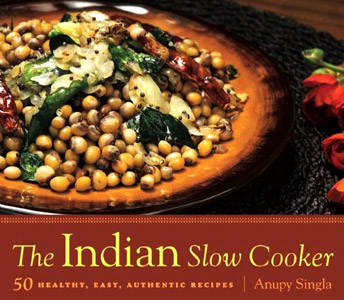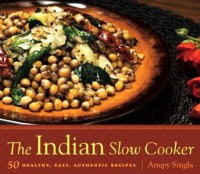Publisher: Surrey Books, An Agate Imprint – 136 pages
Book Review by: Laxmi Chaandi
This book contains 50 easy-to-follow recipes for delicious Indian food.
It is amply illustrated with many full-page and full-color photographs of scrumptious dishes that immediately make your mouth water.
These are mainly vegetarian delights, but towards the end, you get a good share of creative non-vegetarian fare – for example, Pakistani “old clothes” beef curry; lamb biryani and minced lamb with peas; and several chicken dishes, namely the old favorite butter chicken, chicken tikka masala and the traditional Indian chicken curry.
At the outset, in the first chapter, for the benefit of those who are not familiar with Indian food, Anupy Singla has a 32-page primer if you will, on the art of slow Indian cooking which familiarizes you with the ingredients, the breads, the grains (beans, legumes, lentils, peas etc.), pantry staples, fresh and prepared (ground) the spices, and the tools.
Look at the photos of the numerous spices used in Indian cooking. I bet you that if you are not Indian, you most likely have not seen at least half of the grains and spices shown in the photos that are the staples used in Indian dishes.
Your questions as to what’s so special about Indian food and the different Indian ways of cooking are answered in this initial chapter. You also have a section on the best part o this book: How to Eat Indian Food.
There are five other chapters for a total of six that deal with different types of Indian food, namely: lentils; beans and peas: vegetables; meats; sides, deserts and more.
Chapter 2 is on lentils. Most Indian lentils, when boiled in hot water, develop into a pasty soup called dhal. Among the common Indian dhals are masoor dhals (red split lentil); moong dhal; split toor dhal; and urad dhal.
But other lentils, when placed in water and boiled do not blend with the water to become dhals. Instead, they soften enough to become vegetarian dishes. Some of these are the kabuli chana and the kala chana, the Rajmah and sabat urad or black lentil.
Among the tasty dishes made from lentils are shown on pages 46 through 70. Read the recipes here and look at the tasty dishes such as black lentils on page 51; the black lentils with kidney beans on page 52; the black lentils with kidney beans and chick peas on page 53;the split black lentils on page 54; “the simplest of simple yellow lentils” on page 55; the simple spinach and lentil soup on page 56; and the green spinach lentils on page 57.
Beans and peas are the subject of chapter 3. Kidney beans, called Rajmah in India, are a favorite, and they can be cooked into delectable thick soups in numerous ways. Punjabi curried kidney beans are featured first in this chapter, and the photo just makes me say: “oh so good” only because I have tasted similar-looking dishes before.
Chickpeas known as garbanzos in South America and Spanish-speaking countries are known as chole in Indian homes and restaurants.
Six preparations made from chickpeas are featured in this chapter: curried chickpeas, Amla chickpeas, tangy tamarind chickpeas, black chickpea curry, dry, tangy black chickpeas, chickpea curry with fresh dill leaves. Also in chapter 3 are a couple of recipes for black-eyed peas: the Goan black-eyed peas and the cilantro-infused black-eyed peas.
Chapter 4 has recipes of various Indian vegetable dishes. One of my favorites is the spiced cauliflower and potato dish (on pages 90-91).
This dish is made with finely chopped yellow onions, turmeric powder (which gives the dish its yellow color and some flavoring) diced tomatoes, peeled and grated ginger, and Thai chilies vertically sliced.
In a pan adding three tablespoons of canola oil, season the sliced cauliflowers and potatoes with a tablespoon each of cumin seeds, red chile powder, garam masala (a blend of hot Indian ground spices), and salt. Top it with fresh chopped cilantro. You end up with a simply delicious dish that you can enjoy with purely white, fragrant jasmine rice!
In this chapter you will find recipes and photos of, among other vegetarian delights, spicy butternut squash; fenugreek-laced carrots; mustard greens with spinach; curried spinach with homemade cheese; paneer (a tasty dish of cubed milk with spicy spinach); saucy Punjabi potatoes; and chickpea flour curry with vegetables.
Chapter 5 has recipes and photos of meat dishes which we’ve mentioned earlier, and chapter 6 features side dishes such as wet curry, condiments such as mango chutney, accompaniments such as homemade yogurt, and deserts such as rice pudding, and carrot halwa.
The author Anupy Singla has singled out among the best-enjoyed examples of Indian foods in different categories and presented them in readable format in basically three columns, from left to right. Left column has the introduction and description of the dish; the center column with the needed ingredients; and the right column with directions. How much simpler and easier can a cookbook be?
Anupy Singla on WGN (Chicago) Morning News with Pat Tomasulo
showing viewers how to cook Indian basmati rice pudding.
Anupy Singla was a television reporter for Chicago-based and Tribune-owned CLTV for years. She had also reported for Bloomberg News and WGN-TV. She has also written food-related features for the Chicago Sun-Times, Chicago Tribune and Wall Street Journal. She gave all that up and now cooks and teaches cooking from her Lincoln Park home in downtown Chicago.








